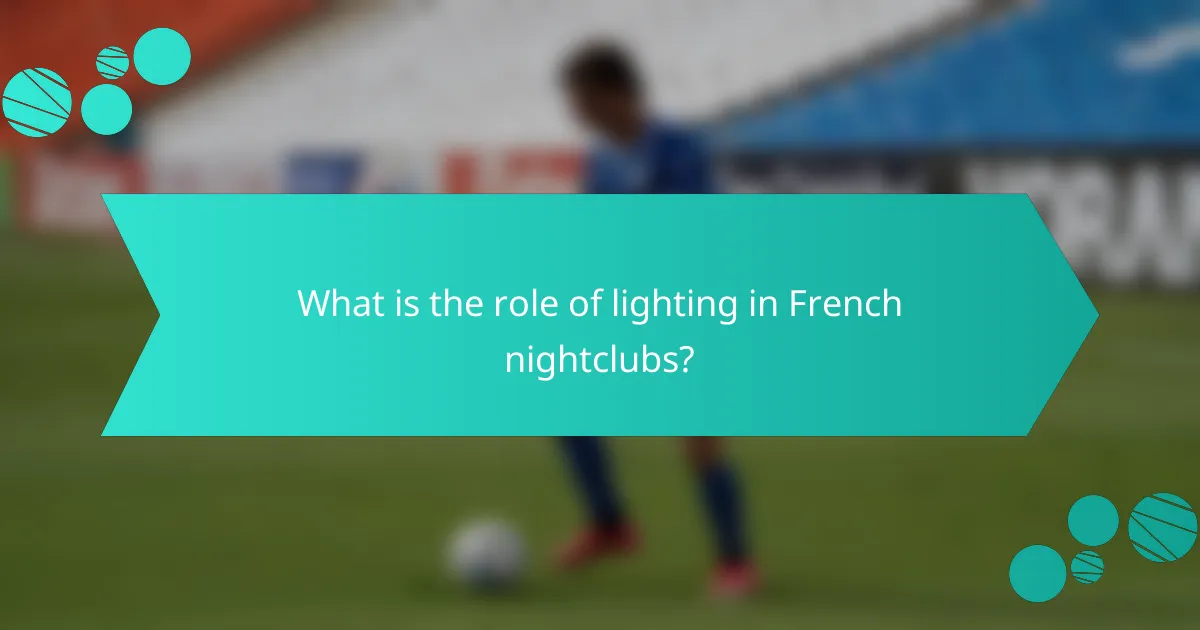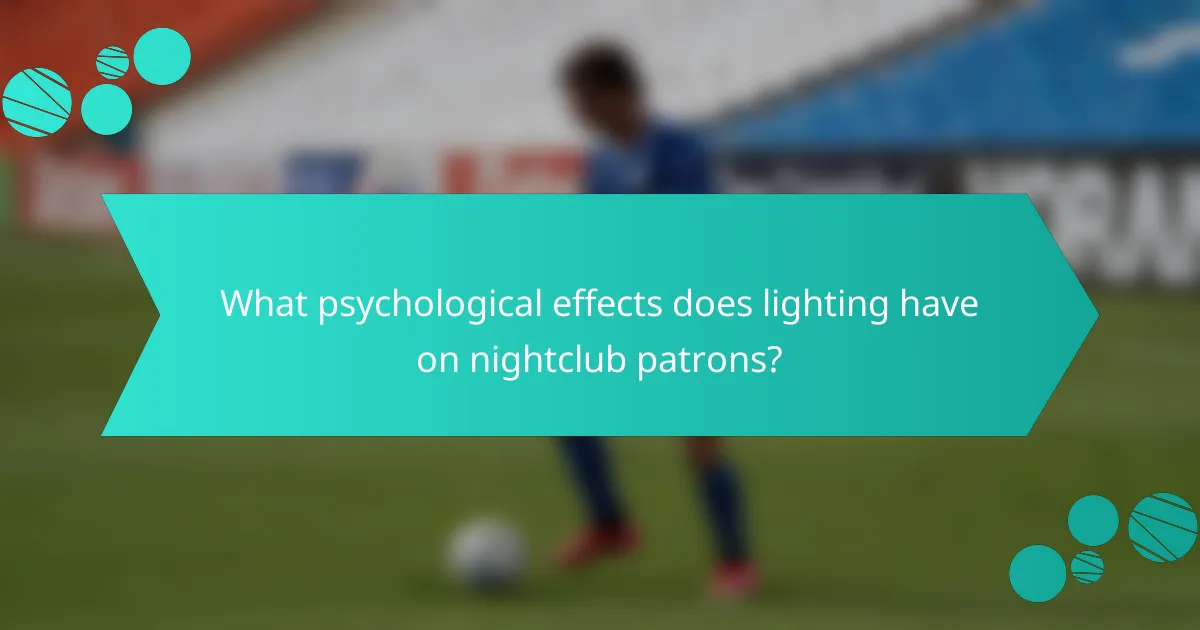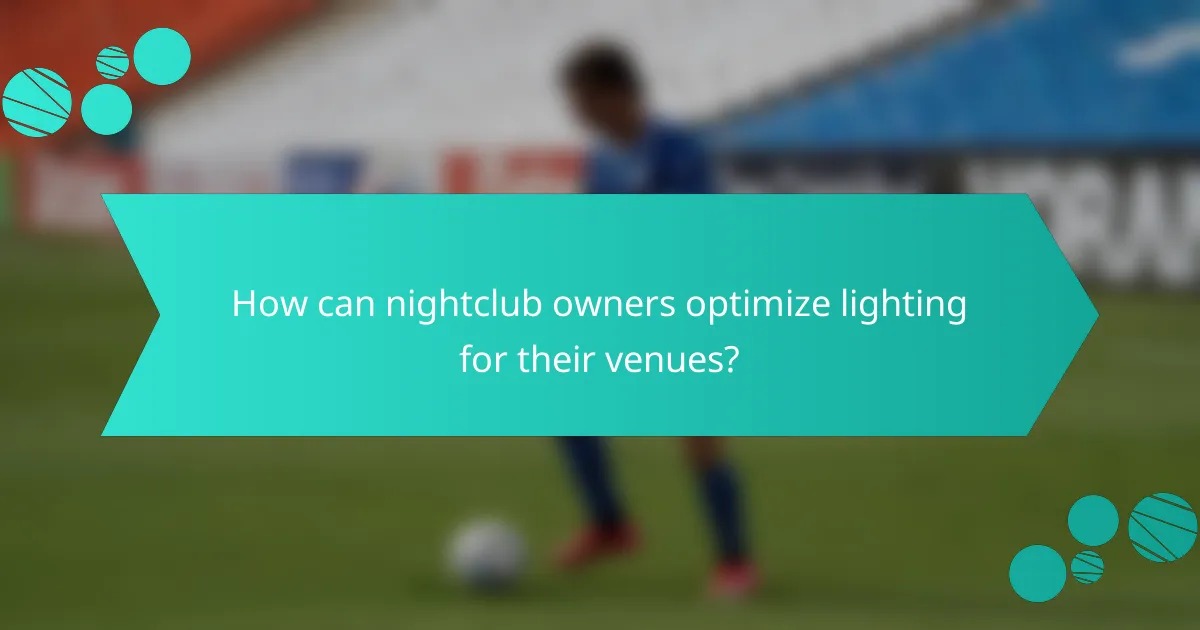Lighting in French nightclubs is a critical element that shapes the atmosphere and influences patrons’ psychological states. This article examines how dynamic lighting enhances the visual experience, affects mood, and promotes social interactions among nightclub patrons. It discusses the impact of different colors and intensities on emotions, highlighting the importance of proper lighting design for increasing satisfaction and dwell time. Additionally, the article outlines effective strategies for nightclub owners to optimize lighting through dynamic systems, strategic placement, and programmable sequences, ultimately enhancing the overall nightlife experience and boosting revenue.

What is the role of lighting in French nightclubs?
Lighting in French nightclubs plays a crucial role in shaping the overall atmosphere. It enhances the visual experience for patrons and influences their mood. Dynamic lighting can create excitement and energy on the dance floor. Different colors and intensities can evoke various emotions. For instance, vibrant colors often stimulate a sense of joy and celebration. Conversely, softer lighting can create intimacy and relaxation. Additionally, synchronized lighting with music enhances the overall sensory experience. Studies show that effective lighting design can increase patron satisfaction and encourage longer stays. Thus, lighting is essential for creating a memorable nightlife experience in French clubs.
How does lighting influence the atmosphere in nightclubs?
Lighting significantly influences the atmosphere in nightclubs by setting the mood and enhancing the overall experience. Different lighting styles, such as strobe lights, LED displays, and colored gels, create distinct vibes. For instance, dim lighting fosters intimacy and relaxation, while bright, dynamic lights energize the crowd. Studies show that lighting affects emotional responses; warm colors can evoke feelings of comfort, while cool colors may stimulate excitement. The synchronization of lighting with music further amplifies the emotional impact. In many French nightclubs, innovative lighting designs are integral to the theme and ambiance, making it a crucial element of the nightlife experience.
What are the different types of lighting used in French nightclubs?
French nightclubs utilize various types of lighting to create ambiance and enhance the experience. Common types include LED lights, which offer vibrant colors and energy efficiency. Strobe lights are used to create rapid flashes that energize the dance floor. Laser lights produce intricate patterns and effects, captivating the audience. Uplighting highlights architectural features and adds depth to the space. Ambient lighting sets the overall mood, often with softer tones. Spotlights focus on performers or specific areas, drawing attention where needed. These lighting types work together to create an engaging atmosphere in French nightclubs.
How does lighting affect the mood of patrons in nightclubs?
Lighting significantly affects the mood of patrons in nightclubs. It can create an inviting atmosphere or evoke specific emotions. Bright lighting often energizes the crowd and encourages movement. Dim lighting, on the other hand, can foster intimacy and relaxation. Color also plays a crucial role; warm hues can create a cozy ambiance, while cool tones might promote a more vibrant feel. Studies show that dynamic lighting changes, such as strobe effects, can heighten excitement and stimulate social interaction. Overall, the strategic use of lighting is essential for enhancing the overall nightclub experience.
Why is effective lighting design crucial for nightclub success?
Effective lighting design is crucial for nightclub success because it creates an engaging atmosphere that enhances the overall experience. Well-designed lighting influences mood and energy levels, encouraging patrons to stay longer. It can highlight specific areas, such as dance floors and bars, drawing attention where it is needed. Research indicates that appropriate lighting can increase customer satisfaction by up to 30%. Additionally, effective lighting can help establish a nightclub’s brand identity, making it memorable. The right lighting also supports visual aesthetics, enhancing decor and architecture. This combination of factors contributes to higher foot traffic and repeat business, ultimately driving profitability.
What are the key elements of successful lighting design in nightclubs?
The key elements of successful lighting design in nightclubs include ambiance, functionality, and technology. Ambiance is created through color choices and intensity. It sets the mood and enhances the overall experience. Functionality ensures that lighting supports the club’s layout and activities. This includes spotlighting performers and illuminating pathways. Technology plays a crucial role in dynamic lighting effects. Advanced systems can synchronize with music, creating an immersive environment. Research indicates that effective lighting can increase patron satisfaction and retention. A study by the Journal of Environmental Psychology highlights the impact of lighting on mood and behavior.
How does lighting design impact customer experience and engagement?
Lighting design significantly impacts customer experience and engagement in nightclubs. Effective lighting creates an inviting atmosphere that enhances mood and encourages social interaction. Research shows that well-designed lighting can increase customer dwell time by up to 30%. This extended stay often leads to higher spending on drinks and services. Additionally, dynamic lighting can stimulate excitement and energy, aligning with music and events. This synchronization fosters a memorable experience, increasing the likelihood of repeat visits. Studies indicate that 70% of customers cite ambiance, including lighting, as critical to their overall enjoyment. Thus, strategic lighting design is essential for maximizing customer engagement and satisfaction in nightclubs.

What psychological effects does lighting have on nightclub patrons?
Lighting significantly influences the psychological state of nightclub patrons. It affects mood, behavior, and social interactions. Bright lighting can energize and stimulate excitement, while dim lighting often creates a relaxed and intimate atmosphere. Research shows that colored lighting can evoke specific emotions; for instance, red lighting is associated with increased energy and passion. Conversely, blue lighting can induce calmness and tranquility. The intensity and color of lighting also impact patrons’ perceptions of space and time. Studies indicate that proper lighting design can enhance the overall experience, leading to longer stays and increased spending. Thus, lighting serves as a crucial element in shaping the psychological experience in nightclubs.
How does color temperature influence emotions in a nightclub setting?
Color temperature significantly influences emotions in a nightclub setting. Warmer color temperatures, such as those around 2700K to 3000K, create a cozy and inviting atmosphere. These hues can evoke feelings of warmth, comfort, and intimacy among patrons. Conversely, cooler color temperatures, typically above 4000K, tend to create a more energetic and stimulating environment. This can enhance feelings of excitement and alertness, encouraging movement and social interaction. Research indicates that lighting can affect mood and behavior, with studies showing that warmer lights promote relaxation while cooler lights can increase energy levels. Thus, the strategic use of color temperature can shape the emotional experience in nightclubs effectively.
What colors are most effective for creating a vibrant atmosphere?
Bright colors such as red, orange, and yellow are most effective for creating a vibrant atmosphere. These colors are known to evoke feelings of energy and excitement. Red stimulates the senses and can increase heart rates. Orange promotes enthusiasm and warmth, making spaces feel inviting. Yellow is associated with happiness and can create a cheerful environment. Research indicates that these colors enhance social interactions and elevate moods. A study by the University of California found that warm colors can lead to increased engagement in social settings. This evidence supports the effectiveness of these colors in vibrant atmospheres, particularly in nightlife environments like French nightclubs.
How do dynamic lighting changes affect patron behavior?
Dynamic lighting changes significantly influence patron behavior in nightclubs. These changes can enhance mood and energy levels. Bright, pulsating lights often encourage dancing and social interaction. Conversely, softer lighting can create a more intimate atmosphere, leading to relaxed conversations. Research indicates that lighting can affect emotional responses, which in turn impacts decision-making. For instance, a study published in the Journal of Environmental Psychology found that brighter environments can increase arousal and excitement. This suggests that dynamic lighting can effectively shape the overall experience and behavior of patrons in nightclubs.
What role does lighting play in enhancing performances and events?
Lighting plays a crucial role in enhancing performances and events by creating mood and atmosphere. It influences audience perception and engagement. Proper lighting design can highlight performers and key moments. It also aids in storytelling by setting the emotional tone. Studies show that dynamic lighting can increase audience excitement and energy levels. For example, a well-lit stage can attract attention and maintain focus. In nightclubs, lighting synchronizes with music to elevate the overall experience. This synergy enhances enjoyment and encourages participation.
How can lighting be synchronized with music for better experiences?
Lighting can be synchronized with music using advanced control systems. These systems analyze audio signals to trigger lighting changes in real-time. For instance, beat detection algorithms can identify the rhythm and tempo of music. This allows lights to pulse or change color in sync with the beat. Additionally, DMX lighting controllers can be programmed to create specific light shows that match musical cues. Research shows that synchronized lighting enhances audience engagement and emotional response. A study by the University of Southern California found that coordinated light and sound experiences significantly improve overall enjoyment.
What are the effects of special lighting effects during live performances?
Special lighting effects during live performances enhance the audience’s experience and emotional engagement. These effects can create a dynamic atmosphere that complements the music and performance. They can influence mood, energize the crowd, and highlight key moments. For instance, studies show that synchronized lighting increases audience excitement and retention of the performance. Furthermore, specific colors can evoke different emotions, such as blue for calmness or red for intensity. The strategic use of lighting can also direct audience attention to performers, enhancing visibility and focus. Overall, special lighting effects are crucial in shaping the overall impact of live performances.

How can nightclub owners optimize lighting for their venues?
Nightclub owners can optimize lighting by using a combination of dynamic lighting systems and strategic placement. Dynamic systems include LED lights that can change color and intensity, enhancing the atmosphere. Strategic placement involves positioning lights to highlight key areas, such as the dance floor and bar.
Additionally, using dimmers allows owners to adjust brightness based on the crowd’s energy. Implementing programmable lighting sequences can create visual effects that match the music tempo. It is also essential to ensure adequate lighting for safety without overwhelming the ambiance.
Research shows that effective lighting can increase patron satisfaction and dwell time, ultimately boosting revenue. According to a study by the University of Southern California, well-designed lighting can enhance the overall experience in nightlife venues.
What are best practices for selecting lighting fixtures in nightclubs?
Select lighting fixtures that enhance the nightclub’s atmosphere. Focus on fixtures that provide adjustable brightness and color options. Consider energy-efficient LED lights for cost-effectiveness and longevity. Use dynamic lighting to create visual interest and engage patrons. Ensure fixtures are durable to withstand high-energy environments. Incorporate fixtures that can sync with music for an immersive experience. Evaluate the layout to optimize light distribution throughout the space. Lastly, prioritize safety by ensuring fixtures are installed securely and comply with regulations.
How can energy efficiency be integrated into nightclub lighting design?
Energy efficiency can be integrated into nightclub lighting design by using LED lighting systems. LEDs consume up to 75% less energy than traditional incandescent bulbs. They also have a longer lifespan, reducing replacement costs and waste. Additionally, smart lighting controls can optimize energy use by adjusting brightness based on occupancy. Implementing motion sensors ensures lights are only on when needed. Dimming systems can also enhance energy savings while creating desired atmospheres. Studies show that energy-efficient lighting can significantly reduce a nightclub’s overall electricity consumption. This approach not only lowers operational costs but also aligns with sustainability goals.
What maintenance practices are essential for nightclub lighting systems?
Regular maintenance practices for nightclub lighting systems include routine inspections, cleaning, and bulb replacement. Inspections should occur monthly to identify any issues. Cleaning fixtures and lenses is essential to maintain optimal light output. Dust and dirt can significantly reduce lighting efficiency. Bulbs should be replaced at the manufacturer’s recommended intervals to ensure consistent brightness. Additionally, checking electrical connections prevents potential hazards. Testing control systems regularly ensures that lighting effects function as intended. Following these practices enhances performance and safety in nightclub environments.
What common challenges do nightclubs face with lighting?
Nightclubs commonly face challenges with lighting related to energy consumption, equipment maintenance, and achieving desired ambiance. High energy costs can arise from extensive lighting setups. Frequent use can lead to equipment failure, requiring regular maintenance and replacement. Additionally, balancing bright and dim lighting is crucial for creating the right atmosphere. Improper lighting can affect guest experience and safety. Nightclubs must also consider the impact of lighting on visual aesthetics and sound perception. These challenges highlight the importance of strategic lighting design in enhancing the overall nightclub experience.
How can nightclubs address issues of lighting inconsistency?
Nightclubs can address issues of lighting inconsistency by implementing a centralized lighting control system. This system allows for real-time adjustments to brightness and color across different areas. Regular maintenance of lighting equipment is essential to ensure optimal performance. Training staff on lighting operation can enhance responsiveness to inconsistencies. Using high-quality, adjustable LED fixtures can provide better uniformity in illumination. Additionally, conducting regular assessments of lighting design can identify areas needing improvement. Research indicates that consistent lighting enhances the overall atmosphere and guest experience in nightclubs.
What solutions exist for adapting lighting to different events?
Solutions for adapting lighting to different events include smart lighting systems, adjustable LED fixtures, and programmable lighting controls. Smart lighting systems allow for remote adjustments and pre-set scenarios tailored to specific events. Adjustable LED fixtures can change color and intensity based on the atmosphere needed. Programmable lighting controls enable dynamic changes throughout an event, enhancing the overall experience. These solutions are widely used in venues to create desired moods and themes. For instance, studies show that proper lighting can significantly influence patrons’ emotions and behaviors in nightclubs.
What tips can nightclub owners implement for effective lighting management?
Nightclub owners can implement several tips for effective lighting management. First, they should use a combination of ambient, task, and accent lighting to create a dynamic atmosphere. This layered approach enhances the visual experience for patrons. Second, utilizing programmable LED lighting allows for flexibility in adjusting colors and patterns throughout the night. This adaptability can match the energy of the crowd. Third, regular maintenance of lighting fixtures ensures optimal performance and safety. Broken lights can detract from the overall experience. Fourth, incorporating dimmers can help control the intensity of the light, setting different moods for various times. Lastly, engaging a professional lighting designer can provide expertise in creating a cohesive lighting strategy tailored to the venue’s unique style. These practices are essential for maximizing the impact of lighting in a nightclub setting.
The main entity of this article is lighting in French nightclubs. The article explores the critical role of lighting in shaping the atmosphere, influencing patron mood, and enhancing overall experiences in nightlife settings. It discusses various types of lighting used, their psychological effects, and the importance of effective lighting design for nightclub success. Additionally, it covers best practices for selecting and managing lighting fixtures, addressing common challenges, and adapting lighting for different events to maximize customer engagement and satisfaction.